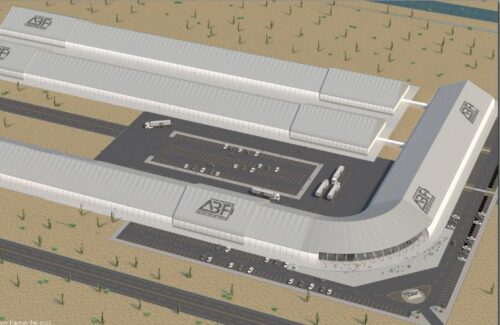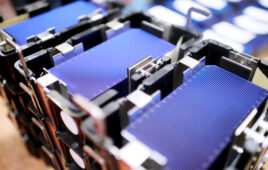
A rendering of ABF’s planned gigafactory in Tucson.
New lithium-iron phosphate battery maker American Battery Factory (ABF) announced that Tucson, Arizona, has been selected as the site for the first in a planned series of battery cell gigafactories based in the United States. The site will serve as ABF’s official headquarters. Approximately 300 high-paying jobs will be provided in the first phase of the factory’s opening, scaling up to 1,000 cumulative jobs. Positions include operations, production, scientific and technology jobs including research and development, automation and robotics, executive and other headquarter positions.
“Arizona is proud to be home to American Battery Factory’s first U.S. facility and headquarters,” said Arizona Governor Doug Ducey. “This transformational investment proves once again that Arizona is the premier destination for emerging technologies. The state-of-the-art factory will produce battery cells critical to our energy future right here in Tucson. My thanks to Paul Charles and the entire team at American Battery Factory for choosing our state for its innovative facility.”
ABF intends to manufacture LFP battery cells for energy storage systems in the 2 million sq-ft plant. To be located on 267 acres in Pima County’s renowned Aerospace Research Campus, ABF’s headquarters will be the home of energy storage innovation, with opportunities for new technology development. Through rapid modular construction, the company plans to have the headquarters, R&D center and initial factory module built within the next 18 to 24 months.
With high-capacity border and transportation infrastructure, Tucson is an ideal fit for ABF’s vision and will provide the necessary access to ship battery cells to nearby markets. Plans for the gigafactory aim to enhance Pima County’s already growing economy and support Arizona’s business community by cultivating an environment that fosters innovation as well as attracting and retaining residents to the Tucson economy.
Project partners include Governor Doug Ducey, Arizona Commerce Authority, Sun Corridor Inc., Pima County, City of Tucson, Pima Community College and Tucson Electric Power.
“With this announcement, American Battery Factory has elevated Arizona’s reputation as a national epicenter for battery manufacturing,” said Sandra Watson, president and CEO of the Arizona Commerce Authority. “American Battery Factory’s new facility and headquarters will advance Southern Arizona’s vibrant technology ecosystem while creating hundreds of skilled jobs and drive further economic growth to our state.”
ABF has secured strategic partnerships, including Celgard (along with their parent company Asahi Kasei) for innovation and key cell components and Anovion for synthetic graphite. ABF plans to work with Honeywell to provide automation, cybersecurity and optimization products and services.
News item from American Battery Factory





Interesting the ABF link is publishing around 6,000 cycles or about one full cycle for 16 years and an actual battery life of from 16 years and a claim of 6,000+ cycles at 20 to 30 years in use. I’ve also come across some information that adding a “front end” of ultra capacitors to the battery pack that feeds the inverter(s) of from 1% to 10% depending on surge currents of devices attached to one’s circuit breaker panel, you can extend the useful life out some 30% to 50% for the battery pack.
“ABF has secured strategic partnerships to make this landmark development a reality, partnering with Celgard (along with their parent company Asahi Kasei) for innovation and key cell components and Anovion for synthetic graphite. ABF plans to work with Honeywell to provide automation, cybersecurity and optimization products and services.”
The ABF site is not very specific on full battery chemistries to be used. It looks like right now ABF is going with “synthetic graphite” from Anovion. When there are companies ramping up right now to use more silicon for anodes as in what NanoGraph is offering. It may still be possible to get a “tuned” chemistry for ABF and mass manufacture (LFP) with more energy density of from 180Wh/kg to maybe 200Wh/kg for battery powered needs. Some of the specifics allowed, Anovion is somewhere around 343mAh/g and NanoGraf claims their silicon anode product starts at 372mAh/g and (can) go to 1,400mAh/g without more context one doesn’t know what it would mean to a LFP battery chemistry.